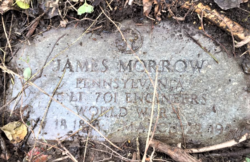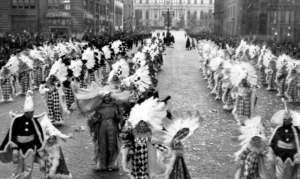Title: Army Second Lieutenant, World War I; deputy sheriff
Birthdate: November 18, 1878
Death Date: March 22, 1954
Plot Location: Section 38, Lot 11

The most fundamentally important thing to someone is their name. John received his middle name in honor of his father, James, but while most documents used his formal name, everyone called him Jim. After 55 years of marriage his widow was so used to that name she reported his name as James on his gravestone, obituary, and death certificate. That’s also how he was listed on his military records, but his given name was John James Morrow.
The family came to America from Ireland before Jim was two years old. Even his date of birth was erroneously reported at times as 1879, 1883 and 1889. That last date was easily ruled out because he got married in 1899. Annie Veronica Foster was his bride’s name, and the first of their ten children arrived in May of 1900. Two of them were twins born in 1907, but both came down with cholera and died in 1908, just three weeks apart.
Jim was a driver and did odd jobs in the years after that tragedy. His parents were living with them at 304 Sears Street off Wharton Street, and his father was a longshoreman. It’s the same neighborhood where Jim and Annie would live their last days almost 50 years later.
The war in Europe began in 1914 but involved the United States in 1917. Jim joined the 701st Engineer Battalion when it was organized in September, 1918. As a Second Lieutenant, he and two  other officers were in charge of a company of 250 “stevedores” who loaded and unloaded ships. Perhaps his assignment was just a coincidence, or maybe he had some experience working with his father on the docks at the end of Wharton Street.
other officers were in charge of a company of 250 “stevedores” who loaded and unloaded ships. Perhaps his assignment was just a coincidence, or maybe he had some experience working with his father on the docks at the end of Wharton Street.
They sailed for France on October 14 and returned three months later. Jim was discharged January 28, 1919, having done his part even though it was for just five months.
Members of the military generally make excellent candidates for law enforcement positions. Jim found his calling in life when the Sheriff’s Office of the City and County of Philadelphia hired him as a deputy sheriff. His career there lasted about 25 years.
With his youngest child born in 1917, family life kept the Morrows busy during the 1920s and 30s. Outside the home and his work, Jim served as a commander of the Slook-Montague Post 354 of the Veterans of Foreign Wars, and was a member of the Republican executive committee of the First Ward.

He also took a special interest in the Mummers Parade, Philly’s New Year’s day tradition. He organized the JJ Morrow String Band that performed four times starting in 1935. The 1938 band came in fifth place out of a field of 18 bands. Shown here is the Quaker City String Band that took third place. His son Bill also entered the parade with his own string band in 1943.
During the later years of his life, Jim worked for the Marine Guard Service, a private company that provides crew transportation for vessels at the Delaware River terminals and other ship-to-shore services. He died at home, 316 Wharton Street in March of 1954, the result of Laennec’s cirrhosis, also known as alcoholic cirrhosis.
Less than four months later his wife, Annie, died of heart failure. Their youngest child, Robert, was the only child other than the twins to die before the parents. He died in 1953 so Annie shared his gravestone. The only other child buried in the Morrow plot was their second child, Margaret, along with her husband and son.

Support the Friends of Mount Moriah
Help us in our mission to restore and maintain the beautiful Mount Moriah Cemetery by donating to our cause or volunteering at one of our clean-up events.

